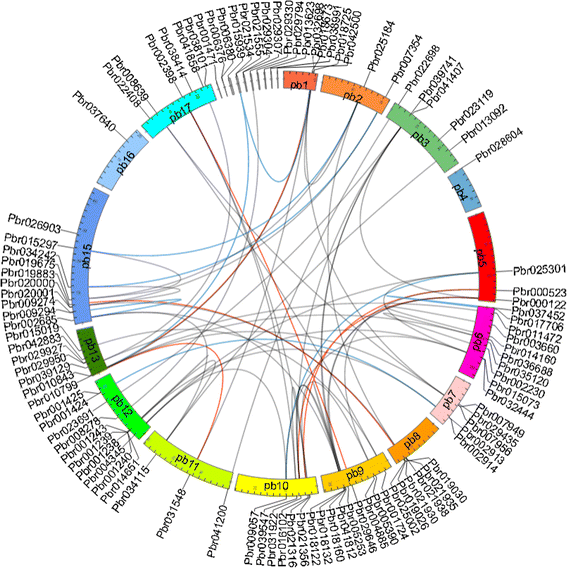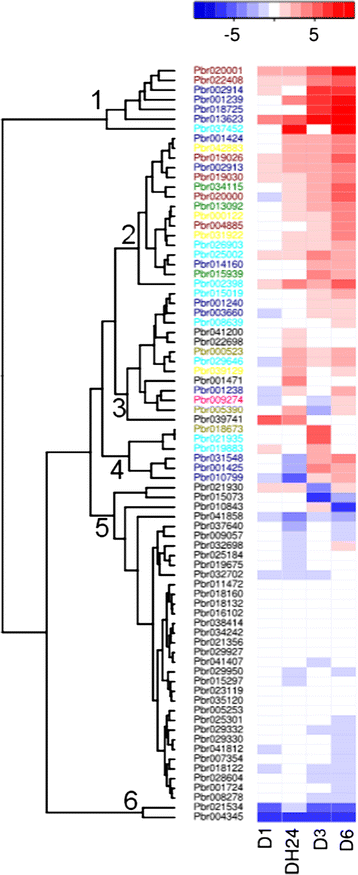Genome-wide analysis of WRKY transcription factors in white pear (Pyrus bretschneideri) reveals evolution and patterns under drought stress
- PMID: 26704366
- PMCID: PMC4691019
- DOI: 10.1186/s12864-015-2233-6
Genome-wide analysis of WRKY transcription factors in white pear (Pyrus bretschneideri) reveals evolution and patterns under drought stress
Abstract
Background: WRKY transcription factors (TFs) constitute one of the largest protein families in higher plants, and its members contain one or two conserved WRKY domains, about 60 amino acid residues with the WRKYGQK sequence followed by a C2H2 or C2HC zinc finger motif. WRKY proteins play significant roles in plant development, and in responses to biotic and abiotic stresses. Pear (Pyrus bretschneideri) is one of the most important fruit crops in the world and is frequently threatened by abiotic stress, such as drought, affecting growth, development and productivity. Although the pear genome sequence has been released, little is known about the WRKY TFs in pear, especially in respond to drought stress at the genome-wide level.
Results: We identified a total of 103 WRKY TFs in the pear genome. Based on the structural features of WRKY proteins and topology of the phylogenetic tree, the pear WRKY (PbWRKY) family was classified into seven groups (Groups 1, 2a-e, and 3). The microsyteny analysis indicated that 33 (32%) PbWRKY genes were tandemly duplicated and 57 genes (55.3%) were segmentally duplicated. RNA-seq experiment data and quantitative real-time reverse transcription PCR revealed that PbWRKY genes in different groups were induced by drought stress, and Group 2a and 3 were mainly involved in the biological pathways in response to drought stress. Furthermore, adaptive evolution analysis detected a significant positive selection for Pbr001425 in Group 3, and its expression pattern differed from that of other members in this group. The present study provides a solid foundation for further functional dissection and molecular evolution of WRKY TFs in pear, especially for improving the water-deficient resistance of pear through manipulation of the PbWRKYs.
Figures





Similar articles
-
Genome-wide analyses and expression patterns under abiotic stress of NAC transcription factors in white pear (Pyrus bretschneideri).BMC Plant Biol. 2019 Apr 25;19(1):161. doi: 10.1186/s12870-019-1760-8. BMC Plant Biol. 2019. PMID: 31023218 Free PMC article.
-
Genome-wide identification and characterization of bZIP transcription factors and their expression profile under abiotic stresses in Chinese pear (Pyrus bretschneideri).BMC Plant Biol. 2021 Sep 9;21(1):413. doi: 10.1186/s12870-021-03191-3. BMC Plant Biol. 2021. PMID: 34503442 Free PMC article.
-
Genome wide identification and predicted functional analyses of NAC transcription factors in Asian pears.BMC Plant Biol. 2018 Oct 3;18(1):214. doi: 10.1186/s12870-018-1427-x. BMC Plant Biol. 2018. PMID: 30285614 Free PMC article.
-
The physiological and molecular mechanisms of WRKY transcription factors regulating drought tolerance: A review.Gene. 2025 Feb 20;938:149176. doi: 10.1016/j.gene.2024.149176. Epub 2024 Dec 16. Gene. 2025. PMID: 39694344 Review.
-
The roles of WRKY transcription factors in Malus spp. and Pyrus spp.Funct Integr Genomics. 2022 Oct;22(5):713-729. doi: 10.1007/s10142-022-00886-0. Epub 2022 Jul 29. Funct Integr Genomics. 2022. PMID: 35906324 Review.
Cited by
-
Identification of the WRKY Gene Family and Characterization of Stress-Responsive Genes in Taraxacum kok-saghyz Rodin.Int J Mol Sci. 2022 Sep 7;23(18):10270. doi: 10.3390/ijms231810270. Int J Mol Sci. 2022. PMID: 36142183 Free PMC article.
-
PbrWRKY62-PbrADC1 module involves in superficial scald development of Pyrus bretschneideri Rehd.fruit via regulating putrescine biosynthesis.Mol Hortic. 2024 Feb 20;4(1):6. doi: 10.1186/s43897-024-00081-8. Mol Hortic. 2024. PMID: 38373989 Free PMC article.
-
Transcriptomics analysis of field-droughted pear (Pyrus spp.) reveals potential drought stress genes and metabolic pathways.PeerJ. 2022 Mar 18;10:e12921. doi: 10.7717/peerj.12921. eCollection 2022. PeerJ. 2022. PMID: 35321406 Free PMC article.
-
Systematic analysis and comparison of the PHD-Finger gene family in Chinese pear (Pyrus bretschneideri) and its role in fruit development.Funct Integr Genomics. 2018 Sep;18(5):519-531. doi: 10.1007/s10142-018-0609-9. Epub 2018 Apr 20. Funct Integr Genomics. 2018. PMID: 29675811
-
Pyrus betulaefolia ERF3 interacts with HsfC1a to coordinately regulate aquaporin PIP1;4 and NCED4 for drought tolerance.Hortic Res. 2024 Mar 30;11(5):uhae090. doi: 10.1093/hr/uhae090. eCollection 2024 May. Hortic Res. 2024. PMID: 38799129 Free PMC article.
References
Publication types
MeSH terms
Substances
LinkOut - more resources
Full Text Sources
Other Literature Sources

